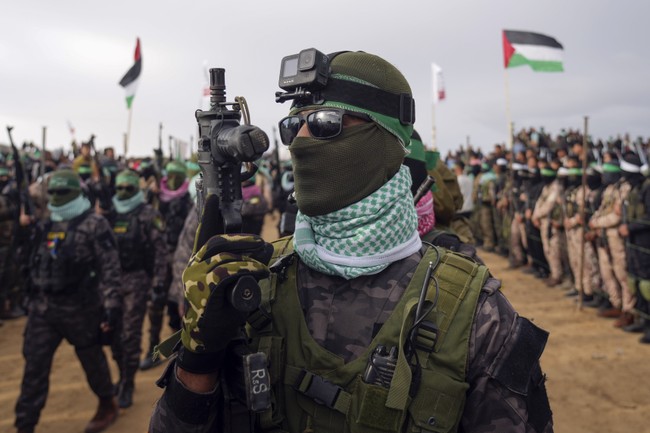
Gaza? Tunnels? Tehran? Yes, the IDF hit Hamas in all of those places, including in Iran’s capital when Israel took out its top leader Ismail Haniyeh.
However, the Wall Street Journal reports that the IDF and Israeli intelligence have struck hardest at the heart of Hamas — its wallet:
Israel last month cut off supplies of humanitarian goods to the enclave, some of which Hamas had been seizing and selling to raise funds, according to Arab, Israeli and Western officials. Its renewed offensive has targeted and killed Hamas officials who played important roles in distributing cash to cadres and sent others into hiding, Arab intelligence officials said.
In recent weeks, the Israeli military has said it killed a money changer who was key to what it called terrorist financing for Hamas as well as a number of top political officials in rapid succession.
The result for Hamas has been a debilitating squeeze.
Salary payments to many Gaza government employees have ceased, while many senior Hamas fighters and political staff began receiving only about half of their pay midway through last month’s Ramadan holy period, the intelligence officials said. Rank-and-file Hamas fighters’ pay had been averaging around $200 to $300 a month, they said.
When the Israelis cut off aid transports after the end of the cease-fire, Western nations howled their objections. However, Israel is under no obligation to feed a population that launched a war against it, at least not unless that population capitulates. More importantly, the cutoff of that aid also eliminated a large amount of the leverage Hamas has over that population and in controlling the forces in Gaza.
This isn’t a police action; it’s a war, one triggered by Hamas with the most monstrous atrocities seen in scope and particulars in decades, if not centuries. Israel warned after the October 7 massacres that the time had come to settle all accounts in the Middle East, especially with Hamas. Unless they surrender and leave Gaza, Israel intends to utterly destroy them rather than return to a frozen conflict that allows Hamas to rebuild again. This time, the Israelis are taking aim at their ability to survive, not just to get them to sign a meaningless cease-fire.
If this sounds familiar, it should. The Israelis used the same strategy against Hezbollah when Iran’s other proxy insisted on joining the war. After Operation Grim Beeper took out most of Hezbollah’s command structure, they eliminated Hassan Nasrallah too, who had been the linchpin of Iran’s proxy strategy for destroying Israel and controlling the region.
But the Israelis also went after Hezbollah’s finances too, targeting their bank Al-Qard al-Hasan (AQAH) both figuratively and literally. The IDF destroyed several AQAH locations around Beirut last fall. That stripped Hezbollah of funds at a moment when Iran had difficulty in transferring enough operational cash to their proxy in Lebanon. As a result of the comprehensive Israeli attack on Hezbollah, they could no longer function as a security force for Iranian toady Bashar al-Assad, who had to flee when his forces collapsed soon after Hezbollah got neutered.
In other words, the Israelis are serious this time about fighting this war as a war.
They’re also serious about traditional military operations. This week they have eliminated a Hamas training camp and killed the man in charge of their smuggling operations, such as they are:
The chief of Hamas’s smuggling unit was killed in an airstrike in southern Gaza’s Khan Younis earlier this week, the IDF and Shin Bet said Thursday, while also announcing the killing of a prominent Palestinian Islamic Jihad member last week.
Yahya Fathi Abd al-Qader Abu Shaar, who worked in recent years to smuggle weapons and other military equipment for Hamas, including equipment used during the terror group’s October 7, 2023, onslaught, was killed on Tuesday, the IDF said. …
Troops of the Golani Brigade operating in the newly created Morag Corridor area, between Rafah and Khan Younis, have demolished a Hamas training camp, the military said Thursday.
The facility, belonging to Hamas’s Shaboura Battalion, included a mock Israeli tank, photos released by the IDF showed.
The IDF said the troops also captured a cache of weapons and destroyed other Hamas infrastructure in the area.
Meanwhile, discussions of a new cease-fire have mainly evaporated. Hamas made clear earlier this week that an Israeli withdrawal would have to take place for any new agreement, and Israel has been answering that demand ever since. The only significant development on hostage talks this week took place in Russia, where Vladimir Putin offered his thoughts on Hamas:
“The fact that you managed to go free is the result of the fact that Russia has stable, long-term relations with the Palestinian people, with its representatives, and with a wide variety of organizations,” Putin told the ex-hostages in a video clip from the meeting published by the state-funded RT television network.
He also hailed Hamas for its “humanitarian act” of releasing them: “We need to express words of gratitude to the leadership of the political wing of Hamas for cooperating with us and carrying out this humanitarian act.”
That speaks volumes … about Putin.

















